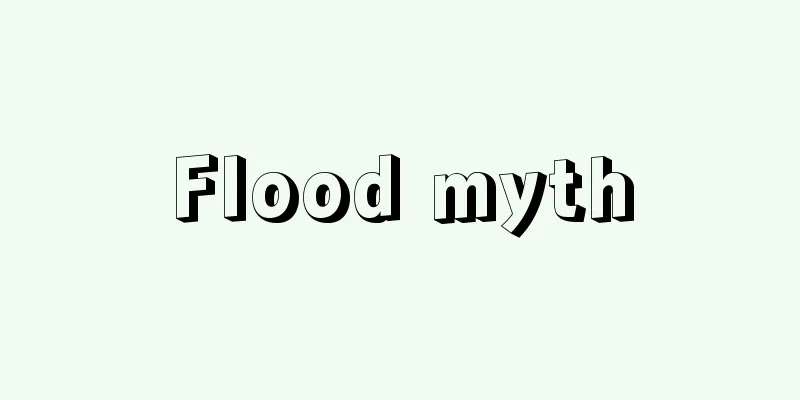Flood myth

|
This is a myth that a great flood occurred in ancient times, wiped out all but a few humans, and that after the waters subsided, a new era began, with the descendants of the survivors becoming the modern human race. This myth is widespread around the world, but there are some areas, such as Africa, where it is believed that there were no indigenous flood myths before the introduction of Christianity and Islam, so it is by no means universal to humanity. The reasons for the flood can be broadly divided into those in which a god was angry at the sins of humanity up to that point (such as disrespecting God) and caused the flood as punishment, and those that do not include such an ethical motive. The former is prominent in ancient Babylonian mythology, as well as in Jewish and Christian mythology, while the majority of flood myths in Southeast Asia and Oceania fall into the latter category. Myths that are not full-fledged flood myths but can be considered variations or similar include the myth that lacks the part about the occurrence of a flood and in which a brother and sister descended from heaven to an island in the ocean in the beginning (Japan, the Ryukyu Islands, and the islands of Southeast Asia), and the version in which humanity is destroyed by fire rather than water (the Lakal people of Assam, etc.).In addition, the story in ancient Chinese mythology in which Yu controlled floods by draining the floodwaters is usually called a flood myth, but it rather belongs to the category of flood-control myths. [Taro Obayashi] Types of Flood MythsFlood myths around the world take various forms depending on the region. According to the Old Testament, God decided to send a flood to punish corrupt humanity, but only the righteous man Noah was chosen by God to survive. Noah got into the ark with his wife, children, and pairs of animals, and sent birds to check if the water had subsided, and then washed up on a mountain. He then offered a burnt offering on the mountain as thanks for escaping disaster. This form, which dates back to Mesopotamian mythology, has also been widely spread around the world through Christianity and Islam. According to the Sanskrit scripture "Shatapata Brahmana," a man named Manu once saved a fish, which advised him to build a boat and enter the water because a flood was coming soon. Manu followed the advice and saved himself, and when he put dairy products such as butter into the water, the fish turned into a woman, and Manu married her and became the ancestor of modern mankind. This type of flood myth is seen in some later Indians and Indian minorities. Also, according to the myth of the Khanty (Ostyak) people of Western Siberia, one day the Supreme God informed his son that a flood would soon come. The son was busy building a boat to save himself and his family, and was always away. So the devil tempted the wife, gave her husband alcohol to find out the secret of his absence, and destroyed the boat, disrupting the Supreme God's command. However, the son built a new boat in three days and was saved, and several people who saw this also built rafts and were saved, becoming the ancestors of various ethnic groups. A distinctive feature of stories from southern China to Southeast Asia is that a brother and sister who survive a flood marry and become the ancestors of mankind. In the myth of the Yao people, a brother and sister escape the flood by riding on a gourd, but as they are the only two who survive, they consult the will of the gods before marrying. Indigenous North American flood myths include a version in which the flood is caused by the tears of a jealous suitor or from inside a monster's belly, or a version in which the souls are saved by climbing a tree that grows so tall it reaches the heavens. In Southeast Asia, Polynesia, and South America, there is also a version in which a flood is caused by a fight between two gods. The basic structure seen in these various flood myths from around the world is a transition from chaos to order, and the beginning of a new era different from the one before the flood. [Taro Obayashi] "Folklore of the Old Testament" by J. G. Fraser, translated by Toru Egawa et al. (1976, Taiyosha) "Myths of the World" by Taro Obayashi (1976, NHK Books) [References] |Source: Shogakukan Encyclopedia Nipponica About Encyclopedia Nipponica Information | Legend |
|
原古に大洪水が起こって人類は少数の者を除いて絶滅し、水が引いたのちに新たな時代が始まって、生存者の子孫が現存人類になったという神話。この神話は世界的に広く分布しているが、アフリカのようにキリスト教やイスラム教の入る前は土着の洪水神話がなかったと思われる地域もあり、けっして人類普遍的なものではない。その洪水発生の理由については、神がそれまでの人類の罪悪(たとえば神を敬わないなど)を怒り、罰として洪水を起こしたという形式と、このような倫理的動機を含まないものとに大別できる。前者が古代バビロニア神話から、ユダヤ、キリスト教の神話において顕著であるのに対し、東南アジアやオセアニアの洪水神話の大部分は後者に入る。本格的な洪水神話ではないが、その変種あるいは類似物とみなすことのできる神話としては、洪水発生の部分を欠き、原初、海洋中の島に兄妹が天降(あまくだ)る神話(日本、琉球(りゅうきゅう)、東南アジア島嶼(とうしょ)部)や、水ではなく火により人類が滅ぼされるという形式(アッサムのラケール人など)がある。なお中国の古代神話にある、禹(う)が氾濫(はんらん)した水を流して洪水を治めたという話は、普通、洪水神話とよんでいるが、むしろこれは治水神話の部類に入る。 [大林太良] 洪水神話の諸類型世界の洪水神話は、地域によってさまざまな形式をとっている。『旧約聖書』によれば、神は堕落した人間を罰するために洪水を送ることを決めたが、正しい人間のノアだけは神から生き残るよう選ばれた。ノアは、箱舟の中に妻子や各種の雌雄一対(つい)の動物を入れて乗り込み、鳥を飛ばして水が引いたかを調べ、山の上に漂着した。そして難を逃れたお礼に山上で燔祭(はんさい)を捧(ささ)げた。メソポタミアの神話にまでさかのぼるこの形式は、他方キリスト教やイスラム教を通じ、広く世界に伝えられた。 インドのサンスクリット聖典『シャタパタ・ブラーフマナ』によれば、昔、マヌという男が1匹の魚を救ったところ、この魚はマヌに、近く洪水が生じるから舟をつくって入るようにと勧めた。これに従って助かったマヌが、水中にバターなどの乳製品を入れるとこれが女となったので、彼女と結婚して現在の人類の祖となった。この系統の洪水神話は後世のインド人やインドの少数民族に若干みられる。また西シベリアのハンティ(オスチャーク)の神話によると、あるとき至高神が近く洪水を送ることを息子に知らせた。それで息子は自分と家族を救うための舟をつくるのに忙しく、いつも不在であった。そこで悪魔がその妻をそそのかし、夫に酒を飲ませて不在の秘密を聞き出させ、その舟を壊して至高神の指令のじゃまをした。しかし、息子は3日で新しい舟をつくって助かり、これを見ていた何人かの人も筏(いかだ)をつくって助かり、さまざまな民族の先祖になったという。 中国南部から東南アジアにかけての特徴は、洪水を生き延びた兄妹が結婚し、人類の祖になるという形式である。ヤオ人の神話では、兄と妹がひょうたんに乗って洪水から助かるが、生き残ったのが彼ら2人だけなので、神意を占ってから結婚したという。北米先住民の洪水神話には、嫉妬(しっと)深い求婚者の涙から、あるいは怪物の腹中から洪水が発生したとか、どんどん伸びて天に入る木を登り助かる形式などがある。このほか、東南アジア、ポリネシア、南米などには、2人の神が争うことによって洪水が起こるという形式もある。このようなさまざまな世界の洪水神話を通じてみられる基本的構造は、混沌(こんとん)から秩序への移行、洪水以前とは異なる新しい時代の開始である。 [大林太良] 『J・G・フレーザー著、江河徹他訳『旧約聖書のフォークロア』(1976・太陽社)』▽『大林太良著『世界の神話』(1976・NHKブックス)』 [参照項目] |出典 小学館 日本大百科全書(ニッポニカ)日本大百科全書(ニッポニカ)について 情報 | 凡例 |
>>: Flood - kouzui (English spelling) flood
Recommend
Center europeen pour la recherche nucléaire
…the abbreviation for the European Organization f...
Gora [Hot Spring] - Gora
A hot spring located on the northeastern slope of ...
Yuè jué shū (English spelling)
A book that records the rise and fall of the state...
Apteryx haastii (English spelling) Apteryxhaastii
… [Hiroyuki Morioka]. … *Some of the terminology ...
Moraea pavonia (English name) Moraeapavonia
…[Tetsuichi Yahara]. … *Some of the terminology t...
Leather metal
The term "katana" refers to the surface ...
Jitodai - land steward
〘 noun 〙 In the Middle Ages, a person who carried ...
Élysée (English spelling)
...The word Elysium, derived from the Latin word,...
ECCS Controversy
…These measures were implemented late, and in 197...
Urban Agriculture
Urban agriculture is a type of agriculture that i...
Audioscope - Audioscope
...We perceive an object as three-dimensional bec...
Akiuji Hosokawa
A military commander during the Northern and Sout...
Kitara Empire
...The backgrounds and factors are so diverse tha...
Eutectic composite material
…By actively utilizing such eutectic structures, ...
Sugamo - Sugamo
A perennial herb of the Zostera family (APG class...









